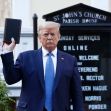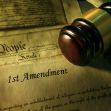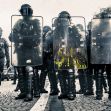Donald Trump issued a Presidential Memorandum on September 2, 2020, ordering a review of hundreds of billions of dollars in annual federal funding for state and local governments that do not embrace his “law and order” agenda wholeheartedly.
Months of ongoing protests since the death of George Floyd have put legislators face to face with controversy. Some reacted with more stringent law to avoid or penalize the escalation of rallies; other state authorities have gone so far as to decline federal forces for assistance with controlling the unrest and agree with the crowds crying for reform of the justice system. Those who chose the latter have evidently made themselves an enemy in the president.
Trump has been hyper-focused on a “law and order” pledge since his June 1 Rose Garden speech, when he repeated the words as shouts and explosions rang out in the background. Attorney General William Barr had infamously ordered an aggressive dispersal of the peaceful protestors outside the White House to indulge a photo op for the president at a nearby church. Many, including the church leader, denounced both Barr and the president for disrupting the peaceful protest with &&tear gas and pepper bombs that day.
With the new order, the Trump administration aims not only to dispel any disagreements with his law and order stance but penalize those who dare deviate. The memorandum explicitly threatens funding to state programs like housing, public transportation, job training, and social services.
The order does not directly cut funding to protest-central cities, but instead calls for an immediate examination of their federal funding with an implied pledge of subsequent action. The first section, which cites Portland, New York, Seattle, and Washington, D.C., as unacceptable examples of lawlessness, is a declaration of authority over funding allocated to the aforementioned offending jurisdictions. “It is also critical to ensure that Federal grants are used effectively,” Trump wrote, “To safeguard taxpayers dollars entrusted to the Federal Government for the benefit of the American people.”
The third section of Trump’s memorandum appoints the Attorney General with the discretionary authority of assigning blame to the state and local governments that “permit anarchy, violence, and destruction in America’s cities.”
This portion of the order directs Barr to quantify precisely which local and state governments are the culprits deserving of hundreds of billions in financial chastisement. The list is to be published no later than September 16 and is not to be updated for at least six months thereafter—so whatever action is to be directed at them, there won’t be an opportunity to escape the Attorney General’s list for half a year or longer.
The memorandum sets out guidelines outlining qualifying factors for Barr to consider when adding
jurisdictions to this list. Several provisions name recent actions of states and cities, such as refusing federal law enforcement to assist with escalating protests. Other conditions are more vague and even unnerving.
One subsection (iii) targets the idea of police reform. Though the concept of “defunding the police” has controversial connotations, it is not the only qualifier named in Trump’s order. It says, “Whether a jurisdiction disempowers or defunds police departments.” One wonders how far the umbrella of the word “disempowers” stretches: has the president just ordered the nation to essentially ignore the public outcry law for justice reform?
The idea behind this “defunding” is simple, yet often misunderstood—it is not actually about abolishing police forces, as some fear. It is about directing funding towards better resources for citizens who are struggling, such as better schools and public housing, plus less police brutality theoretically equals less crime for the police to deal with anyway. The cry to reform and “defund” is actually aimed at just reassessing the funds poured into police departments. Rather than spending such a large chunk of a jurisdiction’s budget on the police force, direct those funds to public safety services and community support systems and education. To offer support and reform and opportunity for the less fortunate, rather than trap them within a system that has, very literally throughout American history, been built and amended with explicit intent to trigger disadvantage in a racially disproportionate manner.
For months, the Black Lives Matter movement has called for reforming and even “defunding” police departments, meaning to reallocate some of the massive amounts of funding afforded to law enforcement, and instead assign that funding to the very same public programs that Trump names in his order. So the president has clearly heard the desires of the nationwide protests to direct funding to those programs, since this memorandum decrees his personal chokehold on exactly those resources.
Another subsection clarifies any questions about the limits to Barr’s discretion, crediting in advance “any other related factors the Attorney General deems appropriate,” affording substantial flexibility to the Bar’s evaluation.
Two weeks after Barr’s list of detriment is due, the Director of the Office of Management and Budget (OMB) is ordered to issue instructions for agencies to effectively disfavor and restrict eligibility for federal funding to the designated cities and states “to the maximum extent permitted by law.” The applicable law to do so, however, is deeply in question for this memorandum.
Ordinarily, a presidential order such as this is accompanied by legal logic as assurance that the mandate is lawful. Even Trump’s recent and divisive executive order to preclude undocumented immigrants from the 2020 census included citations to several U.S. Supreme Court decisions and other legislation to reasonably claim the legitimacy of authority. But this memorandum does not reference a single case or piece of legislation to support its constitutionality.
Instead, Trump references misleading statistics. For example, he mentions “plummeting arrests” in New York City despite rising crime rates. However, NYC arrest rates have consistently trended downwards for the past decade, with annual arrests falling by an average of over 8,500 in the last few years.
But this memorandum targeting “anarchist jurisdictions” still does not include legal citations, probably in part because the precedence is not really in Trump’s favor. The 1987 U.S. Supreme Court case South Dakota v. Dole ruled, “if Congress desires to condition the State’s receipt of federal funds, it ‘must do so unambiguously…enabl(ing) the States to exercise their choice knowingly, cognizant of their participation.” Even if the conditions of Trump’s proposed restrictions were constitutional, the executive branch does not have power over the states’ funding in the way this order assumes.
Beyond Dole, the 10th Amendment to the U.S. Constitution reads, “The powers not delegated to the United States by the Constitution, nor prohibited by it to the states, are reserved to the states respectively, or to the people.” This raises an additional obstacle for Trump’s memo: what the Supreme Court calls “Anti-Commandeering.” This interpretation of the Constitution acts as a barrier to the federal government’s direct authority over state and local officials. However, the order seems determined to surpass the law: in the absence of the power to directly implement his will from the seat of the federal government, Trump intends to discipline anyone who challenges his vision of “law and order” in America.
That “law and order” vow echoes the presidency of Richard Nixon, in which he offered as much amidst the unrest that followed Martin Luther King Jr.’s assassination. In 1968, TIME magazine published a cover story on the campaign message, which some regarded as “a shorthand message promising repression of the black community.” Today, the phrase today stirs up similar uneasiness, especially when the president uses it to issue orders that perhaps disregard constitutional law entirely.






